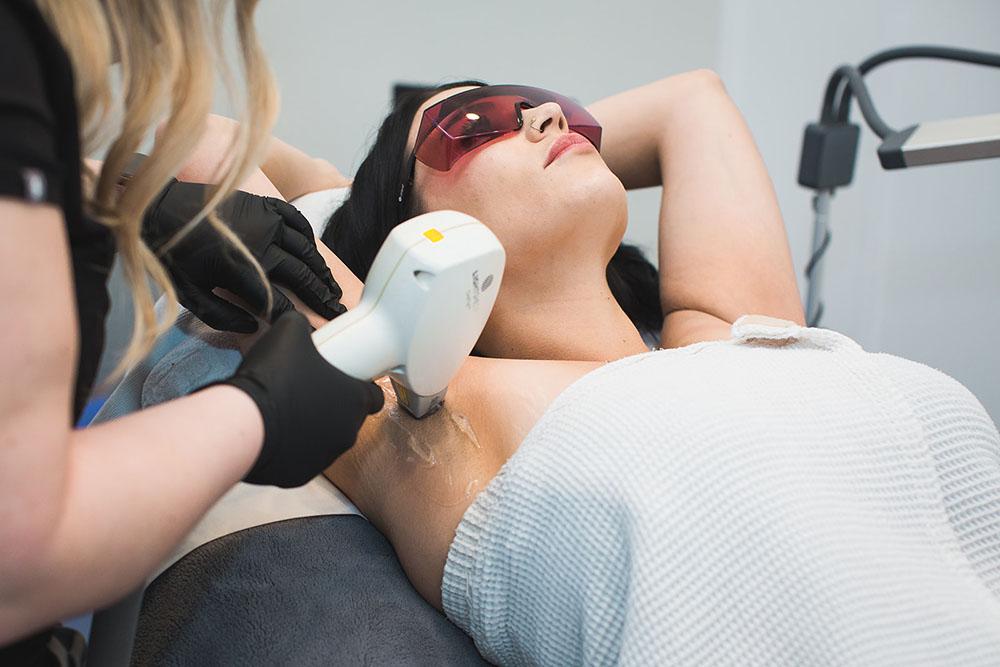Imagine a world where razors are relics and waxing strips gather dust in forgotten bathroom drawers. The humdrum routine of endless shaving, the prickly regrowth, the occasional nicks and cuts—all banished to memory. This is the promise held by laser hair removal, an evolving technology that’s shifting the landscape of personal grooming. But does it truly spell the end of our long relationship with razors and shaving creams? In this exploration, we delve into the possibilities and practicalities of laser hair removal, examining whether it really can free us from the eternal cycle of hair maintenance. Join us as we illuminate the facts and fictions behind this intriguing advancement in cosmetic science.
How Laser Hair Removal Works: Understanding the Science
Laser hair removal fundamentally revolves around the principle of **selective photothermolysis**. This scientific term essentially means targeting specific tissue—hair follicles—using light energy. Here’s the process in a nutshell: The laser emits pulses of light that are absorbed by the melanin (pigment) in the hair. This light energy converts to heat, which then damages the hair follicle, inhibiting future growth. The beauty of this method lies in its precision. The laser can specifically target dark, coarse hairs while leaving the surrounding skin undamaged.
One might wonder why multiple sessions are required for optimal results. Hair growth occurs in cycles, including growth, resting, and shedding phases. Laser treatment is most effective during the *growth phase* (anagen phase), which varies from person to person. Because not all hair is in the growth phase at the same time, multiple sessions are essential to capture *every follicle in its prime state*. This ensures maximum reduction in hair regrowth.
- Quick and Efficient: Each pulse of the laser takes a fraction of a second and can treat many hairs simultaneously.
- Precision: Lasers can selectively target dark, coarse hairs without damaging surrounding skin.
- Predictability: Most patients experience permanent hair loss after three to seven sessions.
To further illustrate, here’s a quick comparison table outlining the importance of various factors in achieving effective laser hair removal:
| Factor | Significance |
|---|---|
| Hair Color | Darker hair absorbs more laser energy, making treatment more effective. |
| Skin Type | Lighter skin reduces the risk of damage, allowing higher laser settings. |
| Hair Growth Cycle | Treatment is most effective during the hair growth phase. |

Weighing the Costs: Is It Worth the Investment?
When it comes to laser hair removal, one of the primary considerations that often comes to mind is the cost. On the surface, it might seem like a significant financial commitment, but let’s dig deeper into what you’re really paying for. The treatment’s expense can vary based on several factors, such as the size of the area being treated, the number of sessions required, and the geographical location of the clinic.
- Area Size: Larger areas like the legs or back require more time and laser pulses, thus increasing the cost.
- Number of Sessions: Most people need 6 to 8 sessions for optimal results, though this can differ based on individual hair and skin types.
- Clinic Location: Prices can fluctuate based on whether the clinic is in a high-demand urban area or a smaller town.
Cost Comparison Table:
| Service | Average Cost per Session | Total Investment (6-8 sessions) |
|---|---|---|
| Small Area (e.g., Upper Lip) | $75 – $150 | $450 - $1,200 |
| Medium Area (e.g., Bikini Line) | $150 – $250 | $900 – $2,000 |
| Large Area (e.g., Legs) | $250 – $500 | $1,500 – $4,000 |
When you weigh these costs against the long-term savings on razors, shaving creams, and waxing appointments, the investment in laser hair removal can start to look quite attractive. Razors, for example, might seem inexpensive on a per-item basis. However, the cumulative cost over a lifetime can easily surpass the one-time investment required for laser hair removal treatments. In addition to financial savings, consider the time you’ll save and the added convenience of no longer needing to shave regularly.

Safety and Side Effects: What You Need to Know
When considering laser hair removal, it’s important to understand the potential safety concerns and side effects. Generally, laser hair removal is a safe and effective method to reduce unwanted hair. However, like any cosmetic procedure, it carries some risks and potential side effects. Immediate reactions are typically minor and short-lasting, such as redness and swelling at the treatment site.
To ensure the best results and minimize risks, here are some key precautions before and after your treatment:
- Avoid sun exposure for at least six weeks before and after the treatment.
- Refrain from plucking, waxing or electrolysis for six weeks before the treatment.
- Use a broad-spectrum sunscreen daily between sessions.
- Follow your practitioner’s specific pre and post-treatment care instructions.
Possible side effects vary depending on skin type, hair color, treatment plan, and adherence to pre-treatment and post-treatment care:
| Side Effect | Description |
|---|---|
| Redness and Irritation | Temporary, similar to a mild sunburn. |
| Crusting | Light crusting may occur, but it’s temporary. |
| Changes in Skin Color | Rare, but hyperpigmentation or hypopigmentation might occur. |
Not all individuals experience significant side effects, but having realistic expectations and understanding the potential reactions will guide you in deciding if laser hair removal is right for you. Consulting with a certified professional and discussing your medical history can also help tailor a treatment plan that minimizes risks.

Choosing the Right Clinic: Tips for Finding the Best Provider
When searching for the perfect clinic to undergo laser hair removal treatment, it’s crucial to keep several factors in mind. First and foremost, **qualifications and experience** should be at the top of your checklist. Look for clinics that employ certified dermatologists and experienced technicians who specialize in laser treatments. This not only ensures safety but also increases the likelihood of achieving outstanding results.
Word of mouth is incredibly valuable when it comes to selecting a clinic. Check out **online reviews and testimonials** from previous clients, as these can provide genuine insights into the clinic’s services and customer satisfaction levels. Don’t hesitate to ask for before-and-after photos, too. Many reputable clinics will have a portfolio of their work readily available, which can give you a clearer understanding of what to expect.
Another critical aspect to consider is the **equipment and technology** used by the clinic. The effectiveness of laser hair removal largely depends on the type of laser machines used. Ensure the clinic utilizes state-of-the-art, FDA-approved technology that’s suitable for your skin type and hair color. Here’s a quick comparison for reference:
| Laser Type | Best For |
|---|---|
| Alexandrite Laser | Light to Olive Skin Tones |
| Diode Laser | All Skin Tones |
| Nd:YAG Laser | Dark Skin Tones |
Lastly, always schedule a **consultation and patch test** before committing to any treatment. During the consultation, discuss your medical history, skin type, and desired outcomes with the clinic’s professionals. A patch test will help determine your skin’s reaction to the laser and minimize the risk of side effects. This step is crucial for both your comfort and the procedure’s success.

Aftercare and Maintenance: Keeping Your Skin Smooth and Healthy
Once you’ve taken the transformative step towards a hair-free life with laser hair removal, it’s crucial to focus on aftercare to ensure smooth and healthy skin. Immediately after the procedure, **cool down the treated area using ice packs or cooling gels**. This helps reduce any swelling or redness that might occur. Refrain from scratching or picking at the treated areas, as this can lead to irritation or even infection.
Avoid sun exposure for at least a week post-treatment. If you must be outdoors, **apply a broad-spectrum sunscreen with an SPF of 30 or higher**. Direct sunlight can cause more harm than good during this sensitive time. Additionally, steer clear of tanning beds, saunas, and steam rooms, as they can exacerbate irritation and delay the healing process.
- Hydrate your skin by using moisturizing lotions that are free from fragrances and harsh chemicals.
- Skip the gym for 24-48 hours to avoid excessive sweating that can irritate the skin.
- Resist the urge to shave or wax between sessions, allowing the treated hair to fall out naturally.
Keeping your skin in top shape isn’t just about what you avoid; it’s also about what you include. A healthy skincare routine can enhance the benefits of laser hair removal. Use gentle cleansers and exfoliating scrubs to keep the skin clean and free of dead cells which can clog pores and hair follicles. Pat dry instead of rubbing after a shower to prevent irritation.
| Skin Care Tip | Action |
|---|---|
| Stay Hydrated | Drink at least 8 glasses of water daily |
| Avoid Harsh Products | Use fragrance-free skin care |
| Regular Exfoliation | Use a gentle scrub 2-3 times a week |
Monitor the condition of your skin and note any unusual changes. If you experience persistent redness, blistering, or any other significant side effects, consult your healthcare provider. A bit of careful attention can go a long way in making sure your skin remains smooth and beautiful, making those moments of stubble and razor burns a thing of the past. With the right aftercare and maintenance, you can fully enjoy the benefits of laser hair removal and keep your skin glowing.
Q&A
Q&A: Laser Hair Removal: The End of Shaving Forever?
Q1: What exactly is laser hair removal?
A1: Laser hair removal is a cosmetic procedure that uses concentrated light beams, or lasers, to target and destroy hair follicles, resulting in long-term hair reduction. It’s designed to provide a more permanent solution compared to traditional methods like shaving or waxing.
Q2: How does the laser actually remove hair?
A2: The laser emits light that is absorbed by the pigment in the hair. This light energy is then converted into heat, which damages the hair follicle and inhibits future hair growth. Because the hair follicles are targeted directly, the surrounding skin remains largely unaffected.
Q3: Is laser hair removal suitable for everyone?
A3: While advancements in technology have made laser hair removal more accessible to a broader range of skin and hair types, it’s still most effective on individuals with light skin and dark hair. People with dark skin or light hair (blonde, white, or red) might not experience the same level of efficacy.
Q4: How many sessions are typically required?
A4: The number of sessions varies depending on the individual and the treatment area, but most people require between 4 to 8 sessions to achieve optimal results. Hair grows in cycles, and multiple treatments are necessary to target all hairs during their growth phase.
Q5: Is the procedure painful?
A5: Pain tolerance varies from person to person, but many describe the sensation as a rubber band snapping against the skin. Some areas may be more sensitive than others. Modern lasers often include cooling mechanisms to minimize discomfort during the procedure.
Q6: Are there any side effects?
A6: Common side effects of laser hair removal include temporary redness, swelling, and a sunburn-like sensation in the treated area. These usually subside within a few hours to a couple of days. Less common, but possible, are blistering, scarring, and changes in skin pigmentation.
Q7: What should someone do before undergoing laser hair removal?
A7: It’s recommended to avoid sun exposure, tanning beds, and self-tanners for several weeks before treatment. Shaving the area a day before the session can also help by ensuring the laser targets the follicles more effectively.
Q8: How long do the results last?
A8: Laser hair removal significantly reduces hair growth, but it’s not always completely permanent. Many people enjoy smooth, hair-free skin for months or even years, but touch-up sessions may be necessary to maintain results over time.
Q9: Is laser hair removal cost-effective compared to shaving or waxing?
A9: While the initial cost of laser hair removal can be higher than buying razors or scheduling waxing appointments, it can be more economical in the long run. The reduction in hair growth means less frequent maintenance, saving both time and money over a lifetime.
Q10: Can laser hair removal really spell the end of shaving forever?
A10: Laser hair removal can drastically reduce or even eliminate the need for regular shaving, but “forever” might be an overstatement. Individual results vary, and some may still need occasional touch-ups to maintain completely hair-free skin. However, it certainly offers a significant reduction in hair growth and maintenance for most people.
Final Thoughts
And so, as beams of light pave the way toward a smoother future, the quest to end the reign of razors continues. Laser hair removal stands as a promising champion, offering a vision of a world where last-minute shaving and razor burns are relics of the past. Yet, in this brave new landscape, questions linger like the finest of stubble—is it the ultimate solution? Perhaps only time will truly tell. Until then, each pulse of the laser brings us one step closer to discovering if the era of shaving is destined to fade into history, or if it will give rise to new traditions in the art of personal care.






